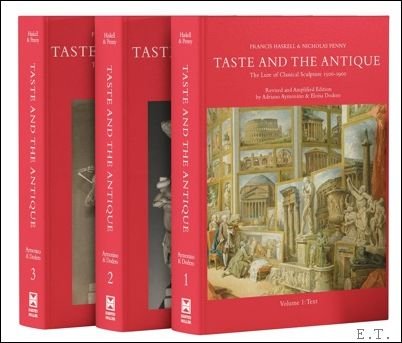Dettagli
Autore
Adriano Aymonino, Eloisa Dodero, Nicholas Penny, Francis Haskell
Editori
, Brepols - Harvey Miller, 2024
Soggetto
Brepols Publishers, Brepols Publishers, Brepols Publishers, Brepols Publishers
Descrizione
hardcovers, 3 vols, 1684 pages, Size:220 x 280 mm, Illustrations:186 b/w, 1592 col. Language(s):English. ISBN 9781909400252. For several hundred years, until about 1900, a limited number of antique sculptures were as much admired as are the Mona Lisa, Botticelli?s Birth of Venus or Michelangelo?s David today. They were reproduced in marble, bronze and lead, as plaster casts in academies and art schools, as porcelain figurines for chimneypieces and as cameos for bracelets and snuffboxes. They were celebrated by poets from Du Bellay and Marino to Byron and D?Annunzio, and memorably evoked by novelists as diverse as Marcel Proust and Nathaniel Hawthorne, George Eliot and Charles Dickens. Copies of some of these statues can be seen at Pavlosk and Madrid, at Stourhead, Charlottenburg, Malibu and Versailles, and in countless gardens, houses and museums throughout the world. How and when did these particular sculptures achieve such a special status? Who were the collectors, restorers, dealers, artists, dilettanti, scholars and archaeologists who created their reputations? Under what names (often wildly fanciful) did they first become famous? How were they interpreted, and how and when and why did their glamour begin to wane? These are some of the problems that are confronted in Taste and the Antique. Taste and the Antique has become a classic of art history since its original publication in 1981. This revised and amplified edition significantly updates the information based on new research undertaken in the last several decades, as well as expanding examples of the reception and influence of these works by artists and collectors from the Renaissance through to contemporary art. The original edition has been expanded into three volumes: Volume 1 is a revised and amplified version of the 1981 edition. Fifteen chapters trace in narrative form, with the support of a wide variety of plates, the rise and decline of this highly important episode in the history of taste. These chapters are followed by catalogue entries for 95 of the most celebrated sculptures, all of them illustrated, which provide information on when and where they were discovered, changes of ownership and nomenclature, as well as a record of varying critical fortunes designed to complement the more general discussion in the earlier chapters. Volume 2 contains especially commissioned new photography of over 90 statues catalogued in Volume 1. Volume 3 is entirely devoted to a visual survey of the full range of replicas and adaptations of the works catalogued and illustrated in the previous volumes. The book is indispensable for historians of taste, and to art historians concerned with the debt owed by numerous artists from the Renaissance onwards to the art of ancient Greece and Rome; and it is also of great value to students and collectors of the many surviving copies of the sculptures discussed. TABLE OF CONTENTS Volume I: Text Preface to the Revised and Amplified Edition An Updated Note on the Presentation of the Essay and Catalogue Introduction I. ?A New Rome? II. The Public and Private Collections of Rome III. Plaster Casts and Prints IV. Control and Codification V. Casts and Copies in Seventeenth-Century Courts VI. ?Tout ce qu?il y a de beau en Italie? VII. Erudite Interests VIII. Florence: The Impact of the Tribuna IX. Museums in Eighteenth-Century Rome X. The New Importance of Naples XI. The Proliferation of Casts and Copies XII. New Fashions in the Copying of Antiquities XIII. Reinterpretations of Antiquity XIV. The Last Dispersals XV. Epilogue Notes to the Text Updated Bibliography Catalogue Appendix Bibliography Index Volume II: Originals Volume III:Replicas and Adaptations

Scopri come utilizzare
Scopri come utilizzare

